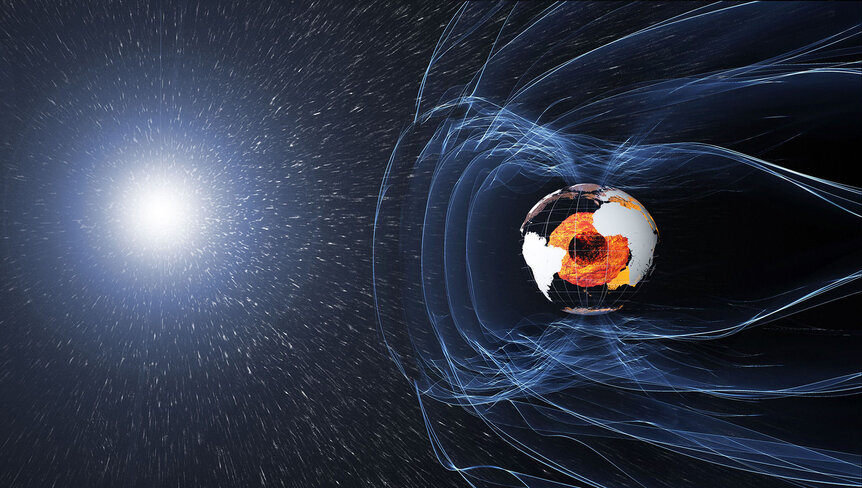Create a free profile to get unlimited access to exclusive videos, sweepstakes, and more!
Earth’s core is speeding up and slowing down
Go home, Earth’s core. You’re drunk.

You’d think, of all the planets in the Universe, the one we’d know best is the one we live on.
But that’s actually part of the problem: Living on it. Earth has 500 million square kilometers of surface area, but a volume of a trillion cubic kilometers. Volume wins, and worse, all that stuff is way down deep inside the planet where we cannot possibly reach it to study.
Still, we do know a lot about what’s going on under our feet. And a lot of what’s happening is just plain weird. For example, we know that the solid inner core of the Earth spins at a slightly different rate than the rest of the planet. Research from about 20 years ago showed it rotates a wee bit faster, moving ahead of the rest of the planet by about a degree per year, which meant it would lap the outer part of the planet’s rotation every 360 years or so. This is called superrotation.
But a new paper just published shows this isn’t quite the case. The scientists involved find that the core superrotated from 1971 to 1974, though by less than earlier estimates. And it gets worse: They find the core actually slowed enough between 1969 and 1971 to spin slower than the rest of the planet above it. It subrotated. It appears the core can speed up and slow down how fast it spins! [Link to paper]
I want to be careful here: The press release says that the core “changed direction,” which is misleading. The core didn’t stop and then start spinning in the other direction! What happened is that relative to the mantle and crust it changed direction, going from moving slowly ahead of us to moving slowly behind. If you were out in space looking down on Earth and could somehow measure the core’s spin, you’d see it would have rotated west to east just like the rest of the planet. It’s just the speed of that rotation changed. It’s like passing a car on the highway; to you it looks like it’s moving backwards, but to someone on the ground it’s just moving slower than you are. Perspective matters here.
So how did they figure this out? Nuclear bombs!
And no, this wasn’t a real-life recreation of The Core.* When countries detonate powerful weapons, like nukes, on Earth’s surface, they generate seismic waves similar to earthquakes that move through the Earth. When they hit the solid inner core the waves are scattered, reflected and refracted (bent), and the inner core’s rotation affects this scattering in ways that can be measured when the waves pass through the planet and once again reach the surface.
In the 1960s and 70s the U.S. and U.S.S.R. tested quite a few nuclear bombs. The Milrow test in 1969 and the Cannikan test in 1971 were both in Alaska, and were roughly 1 and 4 megatons, respectively. Using seismic data from the time, in the new work the scientists showed that the inner core was subrotating at that time, totaling 0.1° over the interval.
They had previously used U.S.S.R. tests to show that the inner core superrotated by 0.3° from 1971 to 1974. Putting all their data together, they find the speed of the inner core’s rotation oscillates, periodically slowing down and speeding up.
Why? Well, the inner core is solid, made up of mostly iron and nickel. The iron forms huge hexagonal crystals that are not smoothly distributed across the core, with a dichotomy between the western and eastern hemispheres. That means the gravity from the inner core isn’t smooth either, and the different hemispheres tug on the Earth’s mantle in different ways. This can change the way the core rotates, slowing it down and speeding it up over time. This is actually quite complicated, as you might expect, and isn’t totally understood. We’re talking about the structure of a ball of iron hotter than the Sun under huge pressures that’s 2,500 km across and buried under a shell of molten iron 2,200 km thick that itself is under more than 5,000 km of hot (though not liquid!) mantle rock. The fact that we know anything about it at all is pretty amazing.
This has an actual effect on us; the length of the day — the time it takes the solid crust to rotate once — shortens and lengthens periodically, increasing and decreasing by a couple of tenths of a millisecond every six years. The scientists find this can be explained by the periodic change in the inner core’s rotation! You probably haven’t noticed, given the change is 0.002 seconds, but to Earth scientists that’s huge.
We’re still learning about the Earth’s interior, including its core, and much of it is still mysterious. But it affects the length of day, our magnetic field, and much more. If we want to understand our planet, we must learn more.
If I may paraphrase The Emerald Tablet, as below, so above.
*I quite enjoyed the movie The Core, though when I reviewed it for my website when it came out I savaged the science of it. Turns out I was a bit premature… and therein lies a very fun story.




























